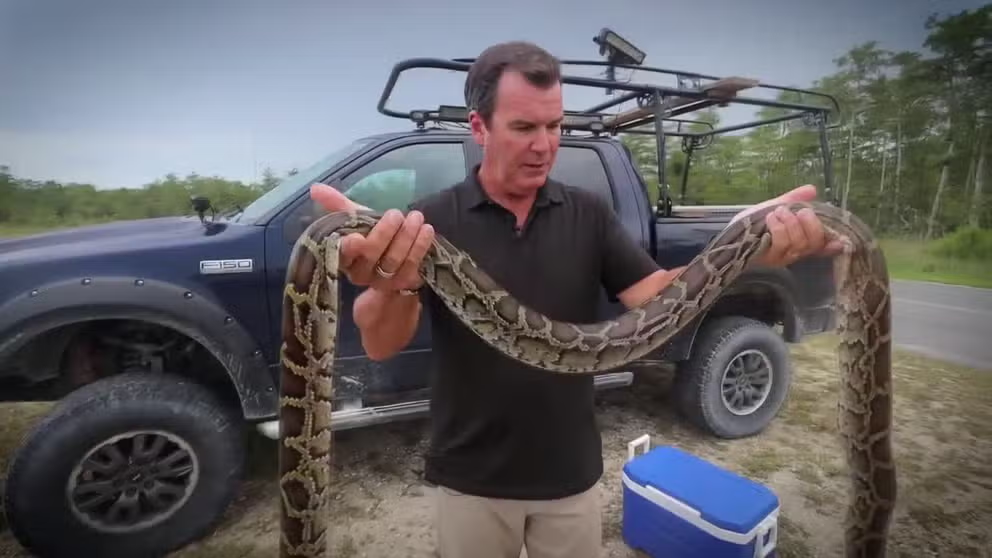University releases 'spy' pythons in Everglades to better understand invasive species
UF estimates 18,000 pythons have been euthanized since 2017, but the exact population is unknown. A 2013 estimate put the Burmese python population between 30,000 and 150,000 snakes in South Florida.
Nearly 18-foot long Burmese python captured in Florida
Ian Bartoszek, Environmental Science Project Manager at the Conservancy of Southwest Florida, joined FOX Weather to talk about the record-breaking capture of the nearly 18-foot Burmese python.
GAINESVILLE, Fla. - As Burmese pythons continue to spread across South Florida, some researchers are turning to high-tech methods to learn more about the slithery invasive species.
The University of Florida said its researchers are embedding small radio trackers in snakes in order to lead them to larger groups of the reptiles.
Biologists admit not much is known about the Florida population, but the hope is that the ‘scout snakes’ program can arm stakeholders with the knowledge to help slow down and eradicate the species.
"It’s the most studied invasive in South Florida, but there’s still so much we still don’t know," University of Florida wildlife ecologist Melissa Miller recently told authors of the university’s Explore magazine. "If we can say, they’re breeding at this time of year, on this tree island, in this type of habitat, we have more ability to detect and remove pythons in the wild. This is an urgent need."
Snakes with embedded trackers are given names such as PyMo-1445 and PyMo-1461 and have led researchers to snake gathering points and increased knowledge about favored habitats.
MASSIVE BURMESE PYTHON CAUGHT SLITHERIN THROUGH SWAMPS OF SOUTH FLORIDA
Growing problem
The National Park Service reports the first Burmese python in the Everglades was spotted in 1979, and the population ballooned during the 1990s.
Today, the snakes can be found as far north of Lake Okeechobee, which has many researchers asking, ‘how far north can the snakes go?’
According to UF, a model suggests that around a third of the U.S. could support the population.

Burmese Python population growth map
(FOX Weather)
But how could they survive the cold weather that places outside of South Florida experience?
The answer, according to researchers, can be found through what has happened to other species - they adapt and mutate to their surroundings.
A cold snap in 2010 that sent temperatures into the 20s in South Florida is thought to have significantly slowed their spread but not entirely stopped it.
Authors of UF’s Explore magazine point out that offspring may develop traits to become more hardy, and burrows and culverts may be sufficient enough to help ride out what are usually temporary cold spells in Florida.
While their threat to humans is considered to be minimal, some populations of prey have experienced a dramatic decline.
Studies show animals such as bobcats, deer, raccoons, rabbits and foxes have all seen declines in the Everglades, as the snakes are able to survive due to their lack of predators.
In fact, humans are only one of a few known predators to the snakes that grow to be between 10 and 20 feet long.
SEE THE MASSIVE ALLIGATOR FOUND LURKING IN A SOUTH FLORIDA SWAMP
The university reports that in addition to radio trackers, drones, artificial intelligence-driven traps and other high-tech solutions are being developed for deployment in South Florida.
The research is part of a five-year project, and there are already more than a dozen snakes roaming the Everglades, with technology helping to disclose their every movement.
On the hunt for pythons in Florida
The invasive Burmese python is a serious threat to the Florida Everglades, preying on native species. Efforts are underway to remove as many as possible, as they also migrate north in search of new prey. FOX13's Mark Wilson joined expert python hunters for the Florida Python Challenge.

